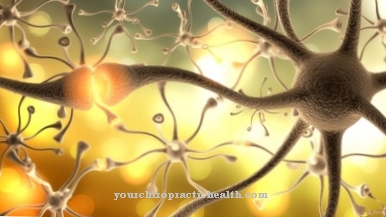With Muscle tension the state of tension of the muscles is called, also called "tone". This is caused by the stimuli of the nervous system and the elasticity of the tissue. The muscle tension can be divided into active and passive, whereby this process always represents the counterforce to the force of the expanding weight. The interaction between the active and passive state have e.g. B. Effects on the whole posture and the stretch-shortening cycle. If the muscle tone becomes painful, there is tension, which is often associated with incorrect posture, is triggered by stress or other factors.
What is the muscle tension?

The muscle is a contractile organ that sets the entire organism in motion through contractions and relaxation of external and internal structures. Because of this physical process, locomotion is possible at all, as is the function of individual organs. Without muscle tension, people would not even be able to maintain their normal posture. Neither sitting nor standing, much less walking would be possible.
The contraction of the muscles is a mechanical process that is triggered by the impulse from the nerves. If you look closely, different protein molecules shift into one another. As soon as the nerves stop pounding the muscle with impulses, it relaxes again.
Basically, the muscles are initially in a so-called resting tone. This means that muscles show their own tension despite being at rest, as well as resistance to external stimuli. The resting muscle is therefore basically exposed to force and tension. On the other hand, there is the active tone triggered by contractions. This voltage can also be measured.
This is done through electromyography, a neurological method to study muscle activity. Concentric needle electrodes are used to derive the potential fluctuations of the motor units, to record individual muscle fibers and to record the actual action potential (the electrical activity of a contracting muscle). A measurement can also be made through the skin using surface electrodes, but this is somewhat less precise.
Function & task
In medicine, a distinction is made between active and passive tension in the muscles. Material properties, the anatomical tissue structure and position, as well as the composition of the muscle fibers play a role in determining the passive tone, as well as the filling status of the intra- and extracellular fluid spaces. Oxygen supply, temperature and blood flow, the degree of fatigue and the type of stress on the muscles also have an influence.
The muscle tension in the skeletal muscles is generated by the contraction of individual muscle fibers. This maintains a level of tension even when the muscles are at rest. The situation is different with the muscle cells of the smooth muscles, which constantly contract and cause constant muscle tension.
With the muscle tension in the resting tone is meant the force with which muscles counteract an acting force. The whole thing is controlled by bevelling the reflex arcs on the muscle, which in turn are neural processes that trigger a body reflex, i.e. muscle tension.
You can find your medication here
➔ Medicines for muscle weaknessIllnesses & ailments
The measurement by electromyography is necessary to check the muscle tension in a person, which can be increased or decreased, as this has a great influence on different areas in the organism, but also on the brain, activity and emotions. It is not uncommon for symptoms to occur in the form of pain, cramp, tension or muscle weakness.
There are numerous triggers for this, which can be more or less harmless but also more serious in nature. Increased muscle tension can lead to pain, e.g. B. in the spinal cord. Back pain in particular is a major burden in everyday life and can sometimes occur as a result of the smallest stimuli that have no recognizable cause. Usually increased muscle tension is associated with hectic rush, stress, lack of exercise or incorrect posture.
Whenever the body is exposed to a stressful situation, it reacts with certain stress reactions, which initially make sense because the body is supplied with energy. The muscles have numerous tasks and therefore also need a lot of energy. With active movements, the energy requirement increases many times over. Heat is a by-product of muscle energy expenditure, so body heat also plays a role in muscle tension.
If the stress continues, the muscles remain under constant strain and tension, the blood vessels expand, breathing becomes shallower, the heart beats faster, the muscle tone increases enormously. Not only the back, but also the neck and shoulders are affected. If the increased muscle tension does not subside, tension will appear, causing pain.
A person's ability to pay attention is also related to muscle tension. In order to perceive people, the environment and oneself at the same time, muscles have to loosen and tense. Since these lie between skin and bones, so to speak, between the inner and outer areas of the body, the world of sensations also depends on them and determines the relationship between external and internal conditions, thus making sensation and the ability to pay attention in the first place.
In fact, muscle tension also affects people's emotions. When the muscles harden, the person feels tense. This tension leads to stress and even creates fear, as events and situations can no longer be resolved and reacted calmly. With greater tension, breathing is shallower, the brain and the entire organism have to get along with less oxygen.
On the other hand, relaxation of the muscles helps, for which there are several methods, including the progressive relaxation technique according to Edmund Jacobsen. A lot of movement, conscious and deep breathing or a hot bath are also sufficient to reduce the increased muscle tension again and thus to build up more inner peace.




























.jpg)